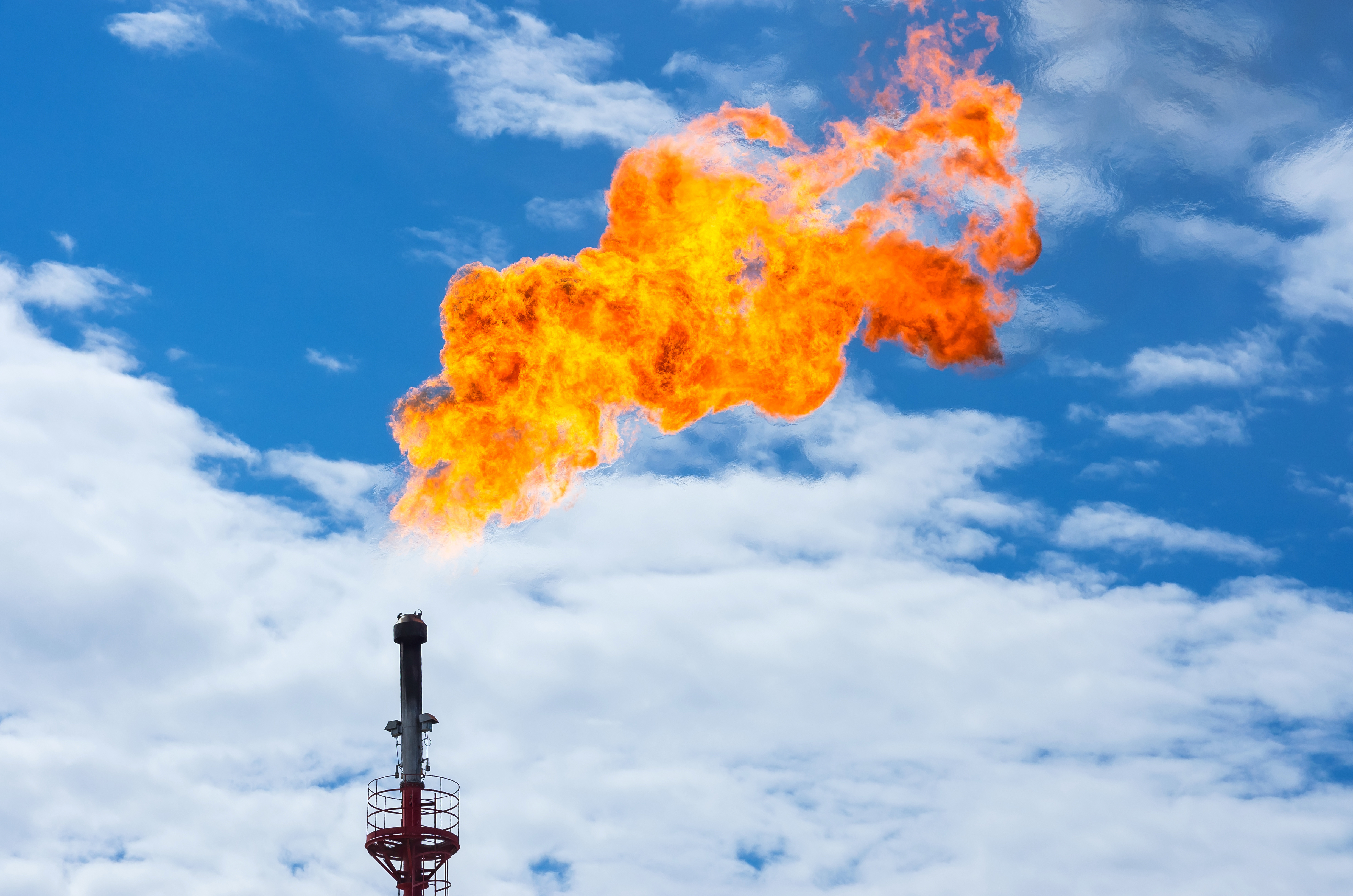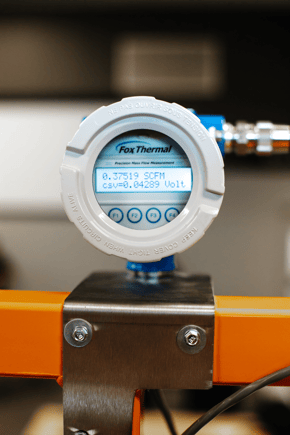Flare gas stacks and combustors are used in many industries including oil & gas, industrial, biogas, and wastewater treatment. These systems are important for burning waste gases produced during operations such as drilling, chemical processing, or biogas reclamation.
In some locations, drilling for oil or natural gas releases hydrocarbon gases that can’t be captured and used, so a gas flare or combustor is needed to relieve excess pressure in the system. Flaring is also used during construction, testing, and maintenance of newly drilled wells or fracking sites.
Digesters used in landfills or wastewater facilities break down waste and produce methane and carbon dioxide, two greenhouse gases (GHGs) that are typically flared, collected for use as a fuel gas in equipment used at the facility, or stored for sale. Flares burn the biogas or waste gases to minimize harmful GHG emissions when flaring becomes necessary due to pressure release events.
Requirements for Accurate Flare Gas Measurement
 Without accurate measurements of the gases being flared, operators may not be able to control the stack function efficiently or report flaring events for proper regulatory compliance. This can lead to a waste of useful resources, as well as fines and penalties from regulators for excess pollutant emissions or even lost royalties to investors.
Without accurate measurements of the gases being flared, operators may not be able to control the stack function efficiently or report flaring events for proper regulatory compliance. This can lead to a waste of useful resources, as well as fines and penalties from regulators for excess pollutant emissions or even lost royalties to investors.
U.S. federal regulation 30 CFR Part 250 states that, for offshore oil & gas facilities producing over 2,000 barrels of oil per day, it is required that the daily volumes of gas flared, gas vented, and liquid hydrocarbons burned must be reported. Other regulations affecting oil and gas operations at well sites and federal leases for flare gas measurement and reporting include 40 CFR Part 98 Subpart W and 40 CFR Part 60 Subpart OOOO (commonly referred to as Quad O). These regulations - put in place by the EPA to reduce methane and other GHG emissions - require flare gas monitoring and reporting. They also have accuracy standards for flow measurement devices.
Challenges to Accurate Measurement of Flare Gases
Flare gas presents several challenges that make it difficult to know how to achieve accurate flare gas measurement.
Changes in Gas Composition
To completely burn off the gas effectively, leaving as few pollutants as possible, operators must determine the correct air-to-fuel ratio for the flare. This is directly related to the types and percentages of gases flowing through the pipe along with the sharp increase in velocity during the upset condition of the flaring event. Finding a flow meter technology that can monitor accurately at both the very low flow rates and the high velocity flow rates of the flaring event is one big challenge. These fluctuations in flow require a meter that can retain accuracy over a wide turndown, possibly up to 1,000:1.
Through the life of the flare or combustor, the actual composition of the flare gases may change. Different gas percentages may be flowing through the pipes at different times and with different flow rates. Flare gases also may be unrefined or consist of other trace gases. A flow meter that cannot account for the change in gas composition may lose accuracy at 10% or greater.
In the case of thermal mass flow meters, flow measurement is based on the heat transfer properties of the specific gas. To maintain the accuracy of the meter when the gas composition changes, it must be reprogrammed and/or re-calibrated to account for the change in gas composition. Some flow meter manufacturers do not offer a way to reprogram the flow meter in the field and the flow meter must be removed from the line, sent back to the manufacturer’s factory, and re-calibrated to the new gas composition. There are also some manufacturers that offer flow meters with the ability to reprogram in the field. Techniques for this process vary and may require additional devices or auxiliary equipment to achieve good results. Look for a manufacturer that provides the simplest solution to gas composition changes and retains its accuracy specifications during gas composition changes.
Maintaining High Accuracy and Regular Calibration
Depending on the regulation, flare meters must measure all flared gas to within 3 to 5 percent accuracy and the meters must be calibrated according to the manufacturer’s recommendations. A flow meter that can be verified in-situ is much more convenient for the user, especially if a certificate stating that the flow meter maintains its NIST-traceable calibration can be produced.
How to Measure Flare Gas Flow
Because of the unique characteristics of flare gas, thermal mass flow meters offer the most cost-effective technology for taking accurate measurements. These meters take advantage of the thermal sensing principle, which relies on a constant temperature differential principle.
Thermal Mass Flow Meter Construction
Thermal mass flow meters contain two Resistance Temperature Detectors (RTDs)—one a reference sensor and the other a heated flow sensor. The two sensor elements are constructed with a reference-grade platinum wire wound around ceramic mandrels that are inserted into stainless steel or Hastelloy tubes. The sensors are mounted on a probe and connected to a transmitter consisting of a microprocessor that calculates flow.
Measuring Flow With Temperature Differential
The probe is inserted directly into the pipe and the reference RTD measures the gas temperature. Meanwhile, the heated sensor element is kept at a constant temperature while the instrument electronics calculate the cooling effect of the gas flow.
Calculation and Data Output
The electrical power required to maintain a constant temperature differential is directly proportional to the mass flow rate of the gas. The microprocessor then linearizes this data to deliver a 4-20mA output signal.
Thermal Mass Flow Meters Are the Best Fit for Flare Gas Measurement
Thermal mass flow measurement technology performs at high levels of accuracy for a wide variety of gases. Flare gas applications are best served by flow meters that are easy to install, have no moving parts, are easy to use, and are proven to work effectively - like thermal mass flow meters.
Other Benefits of Thermal Mass Flow Technology
-
Direct mass flow measurement of gases in standard volumetric units
-
No additional pressure or temperature compensation required
-
Repeatability and exceptionally broad measurement range: up to 1000:1 (100:1 typical)
-
Standard linear 4-20mA output proportional to mass flow rate
-
Low-pressure drop
-
Cost-effective
-
Insertion, inline & remote styles
-
Measures both flow rate and temperature
Easily Change Gas Composition Settings in the Field
Fox Thermal’s digital DDC-Sensor™ interfaces directly with the Model FT4A and FT4X thermal mass flow meter's microprocessor, providing a technology platform for calculating accurate gas correlations using GasSelectX® which calculates gas density and heating value and is accuracy compliant with API 14.10 and BLM 3175.
Correlation algorithms within the flow meter allow it to be calibrated on a single gas in the factory while providing the user the ability to select other gases from menus at the push of a button when the gas composition changes. This process can be performed without removing the flow meter from the pipe or stopping the flow of gas.
Easier Calibration Validation of Flare Gas Meters
To meet the legal and environmental requirements for accurate flare gas measurement, Fox’s Thermal Mass Flow Meters are available with the CAL-V™ calibration validation test that can be performed in-situ and in the field to ensure that the flow meter still retains its NIST-traceable calibration from the factory.
So there’s no need to stop the flow or change process conditions, remove the meter from the pipe, disconnect wires, find old paperwork to compare data, perform additional calculations, or hook up auxiliary equipment. The user can simply perform the test in the field, in-situ, and get pass/fail results in a matter of minutes.

